AMD Ryzen 5 2400G and Ryzen 3 2200G Integrated Graphics Frequency Scaling
by Gavin Bonshor on September 28, 2018 12:30 PM EST- Posted in
- CPUs
- AMD
- GPUs
- Overclocking
- Zen
- APU
- Vega
- Ryzen
- Ryzen 3 2200G
- Ryzen 5 2400G
Ryzen 3 2200G Integrated Graphics OC Performance
Shadow of Mordor
The next title in our testing is a battle of system performance with the open world action-adventure title, Middle Earth: Shadow of Mordor (SoM for short). Produced by Monolith and using the LithTech Jupiter EX engine and numerous detail add-ons, SoM goes for detail and complexity.
The main story itself was written by the same writer as Red Dead Redemption, and it received Zero Punctuation’s Game of The Year in 2014.
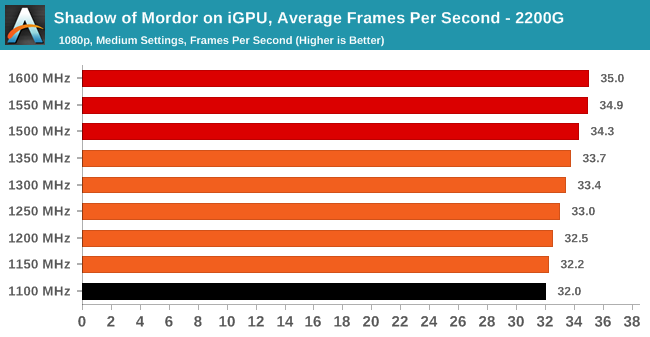
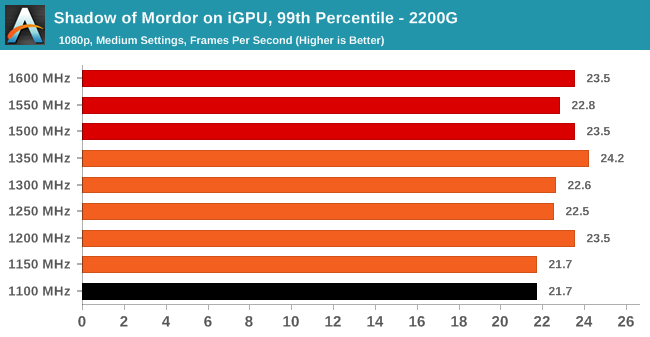
Performance in Shadow of Mordor wasn’t the best we have seen from the game testing, with average framerates gradually increasing on the 2400G. The 99th percentiles given throughout the testing was erratic to say the least.
F1 2017
Released in the same year as the title suggests, F1 2017 is the ninth variant of the franchise to be published and developed by Codemasters. The game is based around the F1 2017 season and has been and licensed by the sports official governing body, the Federation Internationale de l’Automobile (FIA).
F1 2017 features all twenty racing circuits, all twenty drivers across ten teams and allows F1 fans to immerse themselves into the world of Formula One with a rather comprehensive world championship season mode.
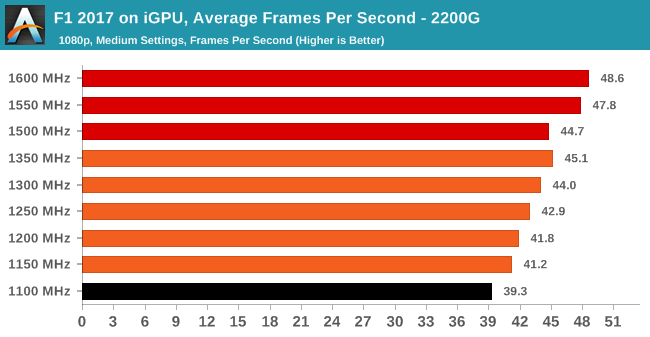
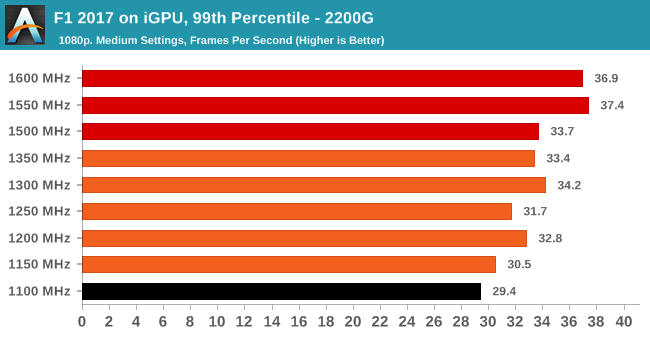
The performance throughout the testing in F1 2017 was consistent in terms of average frame rates with an overall improvement of 9 FPS. The 99th percentile testing was very inconsistent in F1 2017 on both the Ryzen 2200G, but the 2400G too.
Total War: WARHAMMER 2
Not only is the Total War franchise one of the most popular real-time tactical strategy titles of all time, but Sega delve into multiple worlds such as the Roman Empire, Napoleonic era and even Attila the Hun, but more recently they nosedived into the world of Games Workshop via the WARHAMMER series.
Developers Creative Assembly have used their latest RTS battle title with the much talked about DirectX 12 API, just like the original version, Total War: WARHAMMER, so that this title can benefit from all the associated features that comes with it. The game itself is very CPU intensive and is capable of pushing any top end system to their limits.
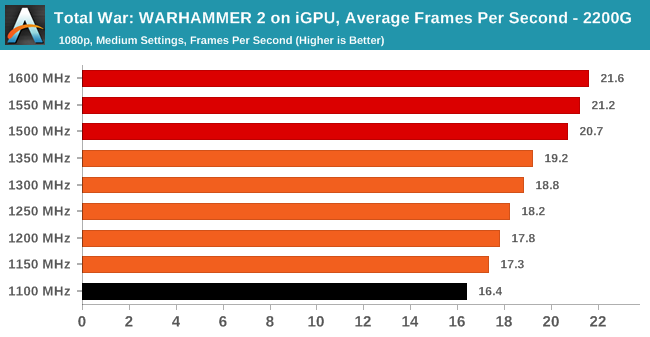
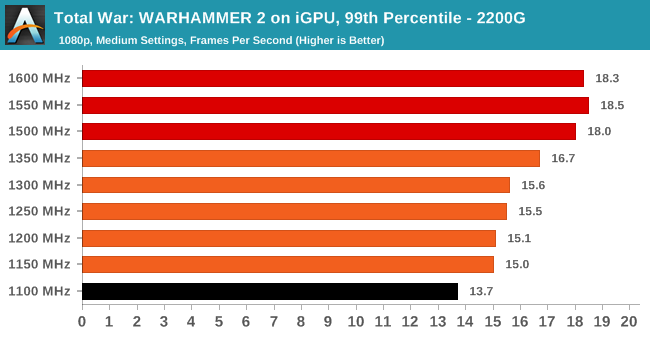
The 2200G managed to pull just under 32% in extra performance in going from 1100 to 1600 MHz on the iGPU and as with multiple games on test, the 99th percentiles of the 2400G seem somewhat capricious. This particular title uses the Warscape Engine and with the 2200G, the performance offered seems more in line with what was expected overall.


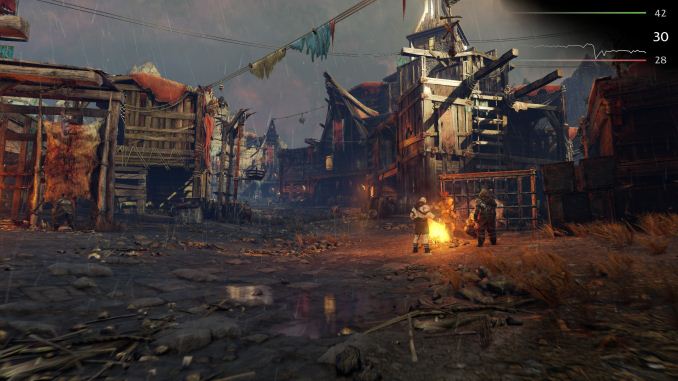
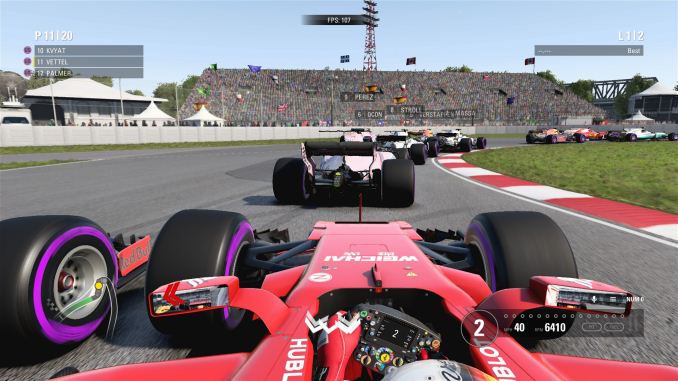
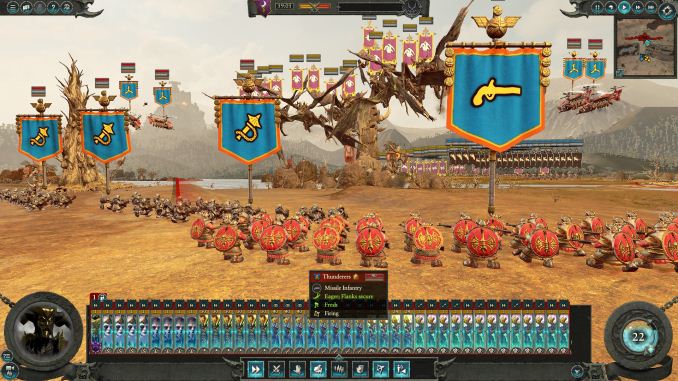








49 Comments
View All Comments
PeachNCream - Friday, September 28, 2018 - link
Interesting analysis, though it's a bit of a foregone conclusion these days to expect a GPU overclock to improve performance in games more than a CPU overclock since the central processor, after a point, has very little role in increasing framerates.This one struck me as odd though - "...Ryzen APUs are marketed for 720p gaming, and while resolutions such as 2160p and 1440p are out of reach purely for performance reasons, we have opted to use moderate settings at 1080p for our testing."
Were the tests executed at 1080p so they would align better in the Bench? It seems more reasonable to test at 720p given the various limits associated with iGPUs in general and the use of 1080p just comes across as lazy in the same way Anandtech tests CPU performance in games at resolutions so high that GPU performance masks the differences in various processors. Tom's Hardware, back when the good doctor actually ran it, yanked resolution down as low as possible to eliminate the GPU as a variable in CPU tests and it was a good thing.
stuffwhy - Friday, September 28, 2018 - link
Just purely speculating, is it possible that 720p results are just great (60+ fps) and need no testing? One could hope.gavbon - Friday, September 28, 2018 - link
My reasoning for selecting 1080p gaming tests over 720p was mainly because the other scaling pieces were running at the same resolution. Not just the iGPU tests, but the dGPU testing with the GTX 1060 too. It wasn't a case of being 'lazy' but the majority of gamers who currently use steam use 1080p and as it's the most popular resolution for gamers, I figured that's where I would lay it down.neblogai - Friday, September 28, 2018 - link
Even if monitor is 1080p, a lot of 2200G users may want to run games on 1080p with resolution scaling, for better fps. In effect, at 720p or 900p. Most games support it these days. So, popularity of 1080p monitors does not really make 720p tests less useful for this level of GPU performance.V900 - Friday, September 28, 2018 - link
Would be great if you had tested just one game at 720p.I know this is what I would be interested in knowing/reading if I was a possible customer.
usernametaken76 - Sunday, September 30, 2018 - link
I honestly think this "majority of gamers who currently use steam use 1080p" argument is affected by a) laptop users (see the high number of 1366x768 users) and therefore game at whatever resolution their laptop panel is set to...Which leads one to ask what the point of testing desktop parts is when you use that as a basis for what and how to test.
TheJian - Friday, October 5, 2018 - link
agree 100%. They do a lot of dumb testing here. Ryan has been claiming 1440p was the "enthusiast resolution" since Geforce 660ti. I don't even think you can say that TODAY as I'm staring at my two monitors (have a 3rd also 1080p), both of which are 1200p/1080p.For me, I need everything turned on, and you need to show where it hits 30fps at that level. Why? Because the designers of the games didn't want you to play their game at "MODERATE SETTINGS"...ROFL. Just ask them. They design EXACTLY WHAT THEY WANT YOU TO SEE. Then for some reason, reviewers ignore this, and benchmark the crap out of situations I'd avoid at all costs. I don't play a game until I can max it on one of my two monitors with my current card. If I want to play something that badly early, I'll buy a new card to do it. All tested resolutions should be MAXED OUT settings wise. Why would I even care how something runs being degraded? Show me the best, or drop dead. This is why I come to anandtech ONLY if I haven't had my fill from everywhere else.
One more point, they also turn cards etc, down. Run as sold, PERIOD. If it's an OC card, show it running with a simple checkbox that OC's it the max the card allows as their defaults. IE most have game mode, etc. Choose the fastest settings their software allows out of their usually 3 or 4 default settings. I'm not talking messing with OCing yourself, I mean their choses 3-4 they give in the software for defaults. Meaning a monkey could do this, so why pretend it isn't shipped to be used like this? What user comes home with an OC card and reverts to NV/AMD default ref card speeds? ROFL. Again, why I dropped this site for the most part. Would you test cars with 3 tires? Nope. They come with 4...LOL. I could go on, but you should get the point. Irrelevant tests are just that.
flyingpants265 - Tuesday, March 5, 2019 - link
Hate to tell you this, but 4k is the enthusiast resolution now.808Hilo - Saturday, October 13, 2018 - link
Is it just me or are these test just for borderline ill people?Playing 4k with a 1080/1800/32/S970. Works reasonably well. I also do everything else in 4k. Would I go back to lower res? No way. Artifical benchmarking is one, real world is 4k. Test this rez and we get a mixed GPU, APU, CPU bench. Build meaningful systems instead of artificially push single building blocks. Push for advancements. T
Targon - Friday, September 28, 2018 - link
The big problem with these APUs is that they limit the number of PCI Express channels, so if you DO decide to add a video card, the APU in this case will reduce performance, compared to a normal CPU without the graphics.